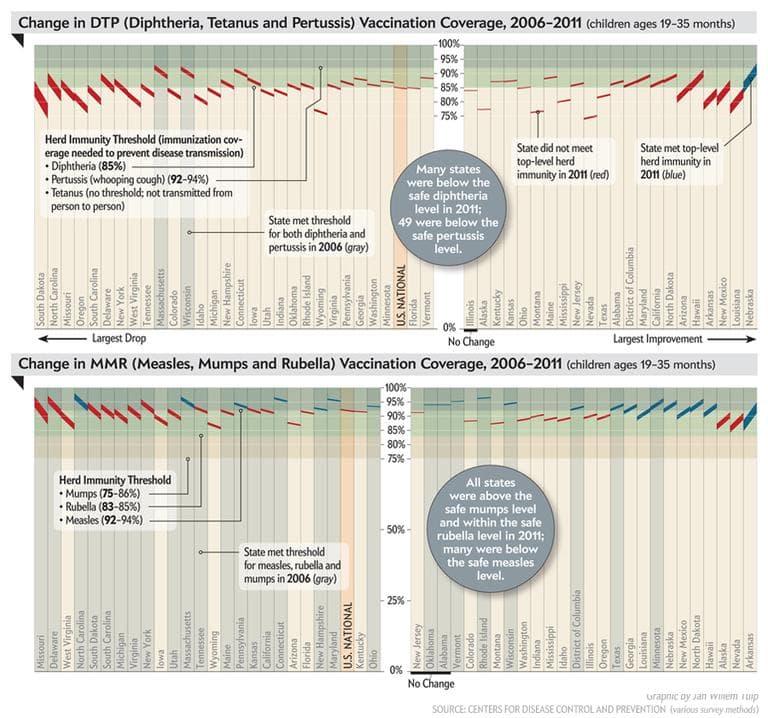Advertisement
Opting-Out Of Vaccines; Dipping Below Herd Immunity

With more and more families opting out of vaccinating their kids, one of the most sacred of public health goals, the concept of herd immunity, is being threatened.
A recent piece in Scientific American featured tantalizing graphics — on view above — illustrating this scary trend. According to this analysis, the vaccination rates in some states — Oregon, West Virginia and Colorado, for instance, are shockingly low. So low, in fact, that they've dropped below the "herd immunity" levels (or what is thought to be the safe threshold) for MMR (measles, mumps and rubella) and DTP (diphtheria, tetanus and pertussis).
So what's the deal with herd immunity? According to the CDC, a population has reached herd immunity when a sufficient proportion is immune to a particular infectious disease. Immune population members get that protection either by being vaccinated or by having a prior infection.
The epidemiological concept is based on this logic:
If the chance of an infectious person crossing paths with a susceptible person is very low — as would be the case in a population whose vaccination rate is at or near herd immunity — then even a very infectious disease may not be able to spread within their population. The more infectious a disease is, the greater the immune proportion of a population must be in order for herd immunity to protect susceptible population members.
But as per the stats presented in Scientific American, a number of states are falling short.
Dr. Kimberly Shea , Assistant Professor of Epidemiology at the Boston University School of Public Health, says that as more and more pockets of non-immunized people emerge, more outbreaks are inevitable. “The big players are pertussis and measles," she says.
A 2010 study documented a measles outbreak in San Diego, California whose roots traced back to a seven-year-old boy who was intentionally un-vaccinated. He came back from a trip to Switzerland not knowing he’d been infected by the measles-causing rubella virus, which resulted in the exposure of approximately 800 people and 11 cases of the measles. Though vaccination coverage in San Diego was high at the time, the study demonstrated that people who aren't vaccinated still pose a threat.
Shea thinks that one key driver behind the parental opt-out trend is misinformation about the risks of vaccination and the severity of the diseases vaccines are designed to protect against. She says that the public health community can help provide correct information – and more of it—to help ease people’s fears.
Until then, if you’re looking for guidance on the vaccinating your child or yourself, Shea has this advice:
"Be wary of unfounded claims about vaccinations and obtain your information from a trusted and reliable source like your health care provider or pediatrician."
This program aired on August 22, 2013. The audio for this program is not available.